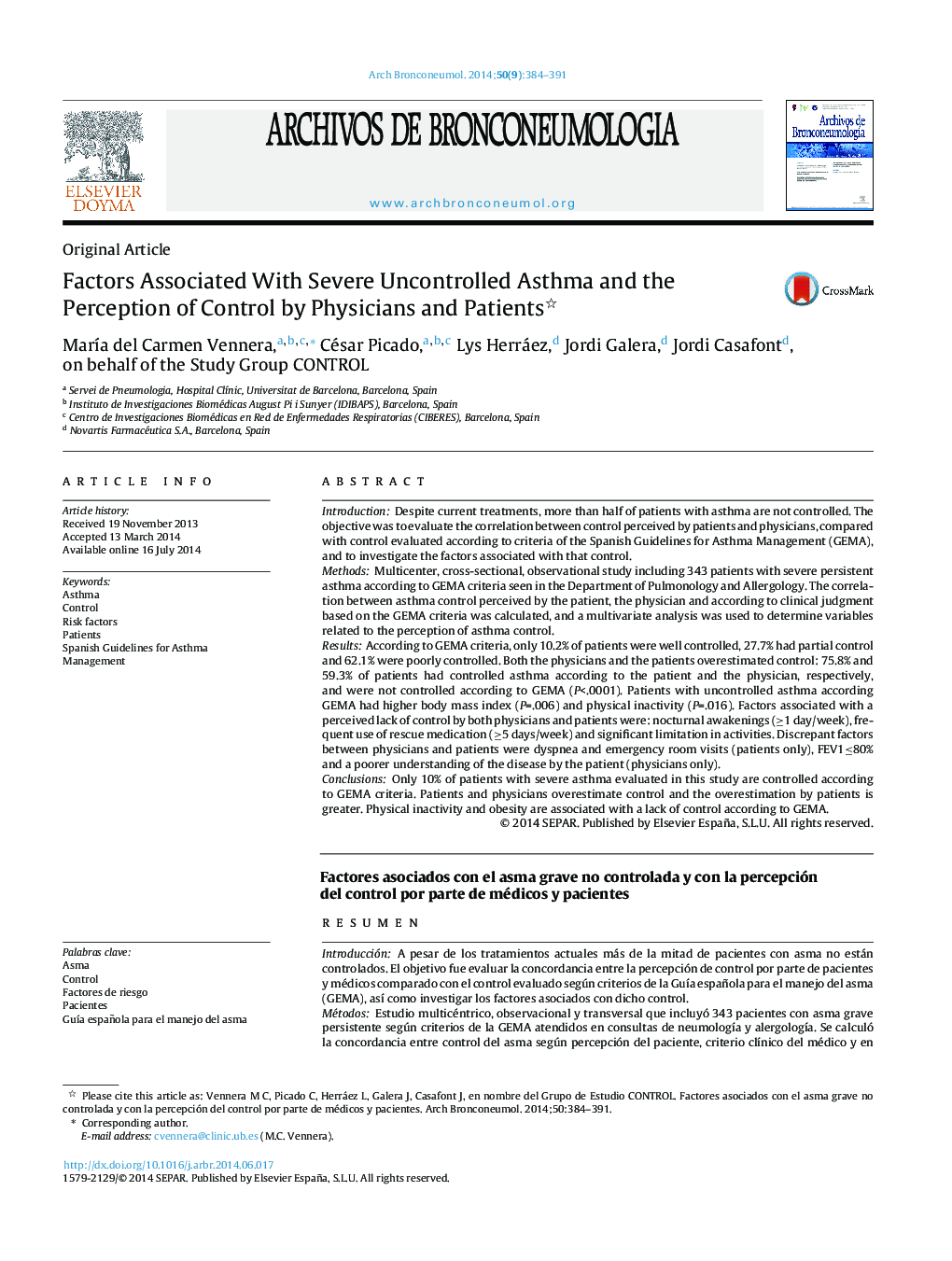| کد مقاله | کد نشریه | سال انتشار | مقاله انگلیسی | نسخه تمام متن |
|---|---|---|---|---|
| 4205589 | 1279919 | 2014 | 8 صفحه PDF | دانلود رایگان |
IntroductionDespite current treatments, more than half of patients with asthma are not controlled. The objective was to evaluate the correlation between control perceived by patients and physicians, compared with control evaluated according to criteria of the Spanish Guidelines for Asthma Management (GEMA), and to investigate the factors associated with that control.MethodsMulticenter, cross-sectional, observational study including 343 patients with severe persistent asthma according to GEMA criteria seen in the Department of Pulmonology and Allergology. The correlation between asthma control perceived by the patient, the physician and according to clinical judgment based on the GEMA criteria was calculated, and a multivariate analysis was used to determine variables related to the perception of asthma control.ResultsAccording to GEMA criteria, only 10.2% of patients were well controlled, 27.7% had partial control and 62.1% were poorly controlled. Both the physicians and the patients overestimated control: 75.8% and 59.3% of patients had controlled asthma according to the patient and the physician, respectively, and were not controlled according to GEMA (P<.0001). Patients with uncontrolled asthma according GEMA had higher body mass index (P=.006) and physical inactivity (P=.016). Factors associated with a perceived lack of control by both physicians and patients were: nocturnal awakenings (≥1 day/week), frequent use of rescue medication (≥5 days/week) and significant limitation in activities. Discrepant factors between physicians and patients were dyspnea and emergency room visits (patients only), FEV1≤80% and a poorer understanding of the disease by the patient (physicians only).ConclusionsOnly 10% of patients with severe asthma evaluated in this study are controlled according to GEMA criteria. Patients and physicians overestimate control and the overestimation by patients is greater. Physical inactivity and obesity are associated with a lack of control according to GEMA.
ResumenIntroducciónA pesar de los tratamientos actuales más de la mitad de pacientes con asma no están controlados. El objetivo fue evaluar la concordancia entre la percepción de control por parte de pacientes y médicos comparado con el control evaluado según criterios de la Guía española para el manejo del asma (GEMA), así como investigar los factores asociados con dicho control.MétodosEstudio multicéntrico, observacional y transversal que incluyó 343 pacientes con asma grave persistente según criterios de la GEMA atendidos en consultas de neumología y alergología. Se calculó la concordancia entre control del asma según percepción del paciente, criterio clínico del médico y en función de criterios GEMA, y se utilizó análisis multivariante para determinar variables relacionadas con la percepción de control del asma.ResultadosSegún criterios GEMA solo el 10,2% de pacientes estaba bien controlado, el 27,7% presentaba control parcial y el 62,1% estaba mal controlado. Tanto médicos como pacientes sobrestimaron el control: el 75,8 y 59,3% de individuos con asma controlada según el propio paciente y su médico, respectivamente, no estaba controlada según GEMA (p < 0,0001). Los pacientes con asma no controlada según GEMA presentaron un mayor índice de masa corporal (p = 0,006) y más sedentarismo (p = 0,016). Los factores asociados a la falta de control percibida tanto por médicos como por pacientes fueron: despertares nocturnos (≥ 1 día/semana), uso frecuente de medicación de rescate (p = 0 días/semana) y limitación importante de actividades. Los factores discordantes entre médicos y pacientes fueron: disnea y visitas a urgencias (solo pacientes); FEVI ≤ 80% y peor conocimiento de la enfermedad por el paciente (solo médicos).ConclusionesSolo el 10% de pacientes con asma grave evaluados en este estudio está controlado según criterios GEMA. Tanto pacientes como médicos sobrestiman el control, con una mayor sobrestimación en pacientes. El sedentarismo y la obesidad se asocian con la falta de control según GEMA.
Journal: Archivos de Bronconeumología (English Edition) - Volume 50, Issue 9, September 2014, Pages 384–391
